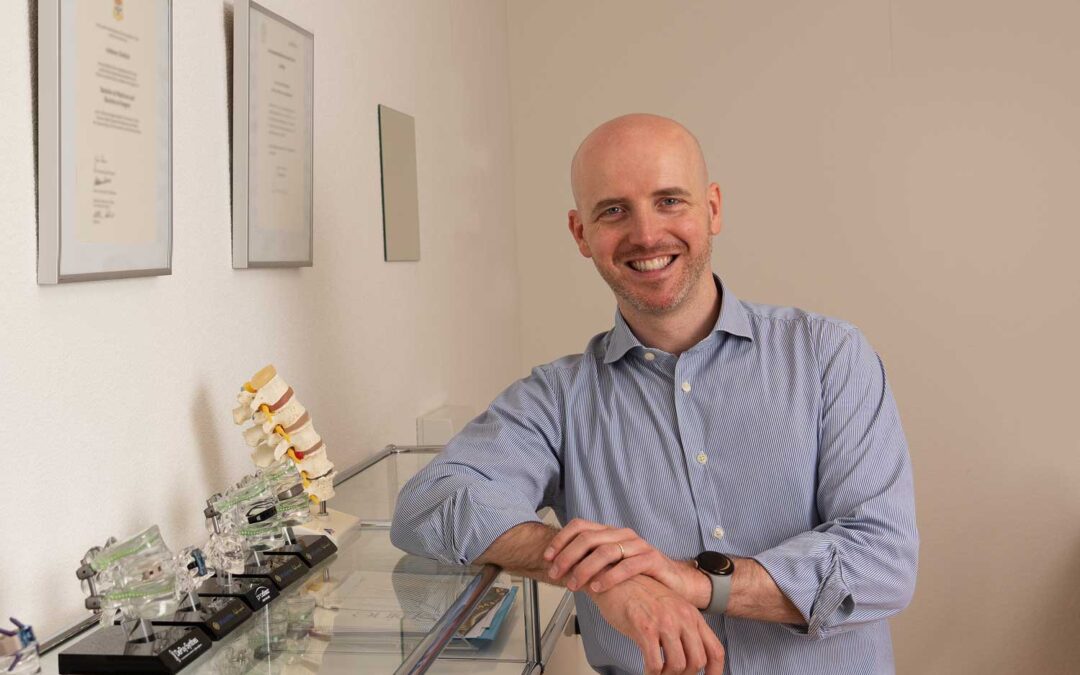Mr. Mandelli, besides your clinical work, you are also part of a research group that studies cervical stenosis, which involves narrowing of the neck part of the spine—what exactly is this about?
I am part of a research group led by PD Dr. med. Cordula Netzer at the University of Basel. Together with the Basel Laboratory for Functional Biomechanics (BFBL), we analyze how patients with spinal conditions move and function. I am heading a project specifically focused on cervical spinal canal stenosis, which is a narrowing of the spinal canal in the neck region. We examine physical activity, including walking patterns, balance, and joint mobility. Our study includes both patients who undergo surgery and those who are initially managed conservatively, meaning without surgery. This allows us to objectively assess the functional status after surgery and to better understand how the condition progresses naturally. The goal is to give patients better information about the best timing for surgery and how the disease develops with or without operation.
What causes these narrowings in the cervical spine? Is everyone likely to be affected sooner or later?
The most common cause is age-related wear and tear of the spine. Over the years, the discs become thinner, ligaments thicken, and extra bone may form around the joints. These changes can gradually narrow the spinal canal where the spinal cord runs. This condition is called cervical spinal canal stenosis. While aging affects everyone, not everyone develops symptoms. Some people show spinal changes but remain symptom-free. Only a subset develop neurological symptoms over time, which is known as myelopathy—a damage to the spinal cord. Other risk factors include being male, smoking, genetic predispositions, or previous injuries.
I want to emphasize that early recognition of typical symptoms is crucial. Signs like worsening balance, fine motor skill problems in the hands (such as difficulty writing, tying earrings, or buttoning clothes), or tingling in the fingers are warning signs that should prompt neurological evaluation.
Surgical treatment of the cervical spine can be very emotional for patients, often related to fears of possible paralysis—is that justified?
This concern is understandable, but fortunately, serious complications like permanent paralysis are very rare. Such severe outcomes occur in less than 1% of cases. However, there is a broad “gray zone” of possible nerve effects: all four limbs can be affected, or sometimes only specific movements, like finger movements, might be impacted. The good news is that the more serious the potential paralysis caused by surgery could be, the less likely it is to actually happen.
The surgical approaches to cervical stenosis can be from the front or the back of the neck. The main goal is to widen the spinal canal to relieve pressure on the spinal cord and improve blood flow. Sometimes, stabilization with implants is also needed. Different approaches have different risks, but overall, these surgeries are considered safe.
When I discuss surgery with my patients, I also review their expectations to avoid unrealistic hopes or disappointment later. Some functional improvement is often possible, but the primary goal is to prevent further worsening. The longer and more severe the symptoms and the older the patient, the less likely full recovery will be after surgery.
Patients are often worried or unsure about what will happen after surgery. Can you explain the typical postoperative course?
Recovery after these surgeries usually happens faster than many patients expect. On the day of surgery, or at the latest the day after, patients are usually able to get up, walk around, and resume daily activities—as long as they don’t perform extreme movements or strenuous loads on the neck.
Besides research, you also work in a hospital. Your surgical work comes with great responsibility for your patients—what motivates you in this clinical role?
What motivates me most is the chance to significantly improve my patients’ quality of life. When someone can walk again independently or pick up objects after surgery, that’s very fulfilling. The responsibility is significant, but that’s also what makes my work meaningful. I have trained for many years to take on this responsibility. Research and clinical work complement each other well: new scientific findings are directly applied to patient care, which ultimately benefits the patients.
